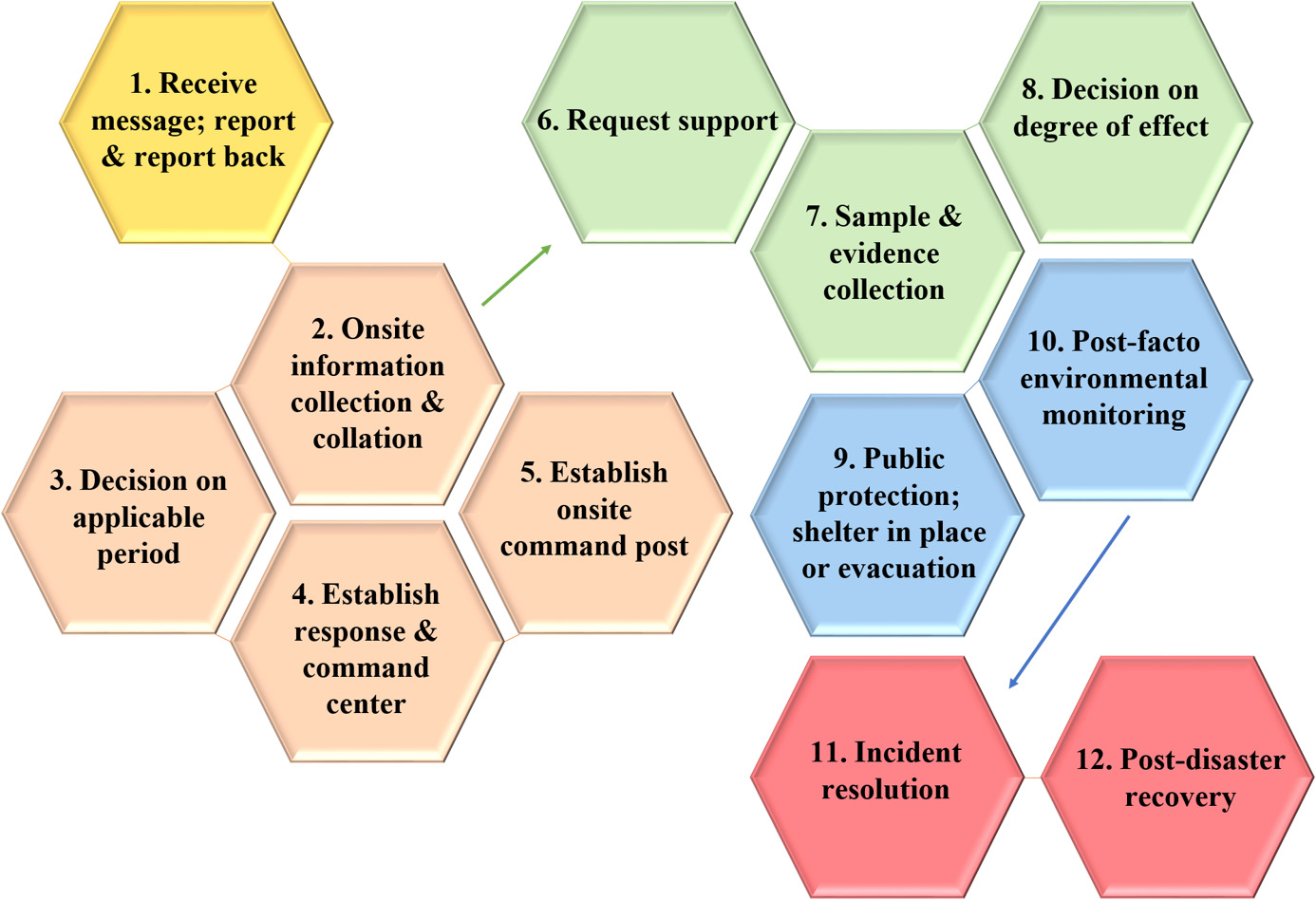A. Background
After the occurrences of the dispute involving air pollution in Dafa Industrial Park which affected the health of teachers and students, and the air pollution incident caused by the occupational safety incident at the Formosa Plastics sixth naphtha cracker plant, the Ministry of Environment issued "Standard Practices for the Response and Handling of Air Pollution Emergency" on October 26, 2009 to strengthen local environmental protection agencies' prompt response ability to deal with the air pollution incidents within their jurisdiction. According to the "Standard Practices", local environmental protection bureaus act as the main implementation units responsible for notification, evidence collection, monitoring and post-disaster supervision. The Department of Air Quality Protection & Noise Control receives information reported/responded by environmental protection bureaus, stays on top of the progress of incidents, and provides required manpower, equipment or technology after receiving requests from the environmental protection bureaus.
The "Central Emergency Response Procedures" was set up based on different air pollution emergency scenarios in 2011. In 2012, a trial implementation of the mechanism that integrated the "Air Pollution Incident Response" and "Toxic Chemical Accident Emergency Response" was promoted. Moreover, the Air Pollution Support Team has been set under MOENV Consulting and Monitoring Center since 2014 to organize and analyze the real-time information of air pollution incidents, with which the Technical Team for Environmental Accident works to assist in the implementation of sample collection and evidence preservation for air pollution incidents where necessary.
B. Implementation Status
In order to enhance the preventive management energy for air pollution emergencies and strengthen the emergency response mechanisms, related work items have been carried out successively throughout the projects implemented over the years.
In terms of prevention and preparedness, the main tasks include:
- (1) Establish an assessment model for substances, manufacturing processes and industrial zones that are prone to air pollution accidents, and have screened out 29 substances, manufacturing processes and industrial zones with potential risks;
- (2) Formulate and publish the "Emergency Measures & Plans for Air Pollution Accidents and Operational Directions for Warning and Notification" to strengthen the prevention/preparedness capability and warning/notification methods for air pollution accidents;
- (3) Develop further "Emergency Measures & Plans for Air Pollution Accidents" to achieve the purpose of prevention/preparedness and to reduce the impacts of accidents on the environment.
In terms of the response to incidents, the main tasks include:
- (1) Continue to revise the "Standard Operating Procedures for Air Pollution Incident Response and Handling" for local environmental protection bureaus to follow when responding to the incidents;
- (2) Update/maintain the "Enquiry System for the Response and Handling of Air Pollution Incident" on a monthly basis;
- (3) Establish a contact list of environmental protection agencies and other air-pollution-related departments/units, and update the information quarterly;
- (4) Prepare and organize the equipment and software frequently used for the responses to air pollution incidents, and perform regular inspections and necessary calibration and maintenance;
- (5) Conduct unannounced communication tests before long holidays on the air pollution emergency contact persons of central and local competent authorities.
 The figure shows All stages of Air Pollution Incident Response, includes (1)Receive message, report and report back; (2)onsite information collection and collation; (3)decision on applicable period; (4)establish response and command center; (5)establish onsite command post; (6)request support; (7)sample and evidence collection; (8)decision on degree of effect; (9)public proctection shelter in place or evacuation; (10)post-facto environmental monitoring; (11)incident resolution; (12)post-disaster recovery.
The figure shows All stages of Air Pollution Incident Response, includes (1)Receive message, report and report back; (2)onsite information collection and collation; (3)decision on applicable period; (4)establish response and command center; (5)establish onsite command post; (6)request support; (7)sample and evidence collection; (8)decision on degree of effect; (9)public proctection shelter in place or evacuation; (10)post-facto environmental monitoring; (11)incident resolution; (12)post-disaster recovery.
Fig. 1. All stages of Air Pollution Incident Response
With respect to assisting local environmental protection bureaus in enhancing energy for response, the main tasks include:
- (1) Organize seminars every year to explain the latest work items promoted by the Ministry of Environment, propagate the matters to note when responding to incidents/accidents, and provide opportunities for local environmental protection bureaus to share experiences with each other;
- (2) Attend the air pollution response drills conducted by local governments, and offer suggestions for improvement when necessary;
- (3) Conduct educational training courses in relation to topics such as simulation and analysis of leakage and diffusion, personal protection, monitoring/detecting of air pollutants, and so on.
C. Future Directions and Goals
In addition to the current work items for preparedness and response operations, MOENV shall continue to upgrade its own and local environmental protection bureaus’ response ability, reinforce the prevention management of factories, and provide people with real-time protection information when necessary. The related plans include:
- 1. Continue the data establishment of the "Support System for Air Pollution Response Decision-making" to provide more complete information about the possible influence area and pollution degree of air pollutants when an incident occurs.
- 2. When a serious air pollution incident occurs, if necessary, provide the people who are in the areas affected by the pollutants with information obtained based on the results of diffusion simulation, onsite measurements and meteorological conditions for people to evacuate, seek shelter and take other protective measures.
- 3. Compile and analyze the causes of common incidents, and strengthen the inspection and control of similar incident sites in the hope of reducing the accident incidence rate and the degree of incident impacts.
- 4. Strengthen the prevention/preparedness for air pollution response and the notification and emergency response procedures, and support local governments in matters relating to prevention/preparedness/control and accident consultation.